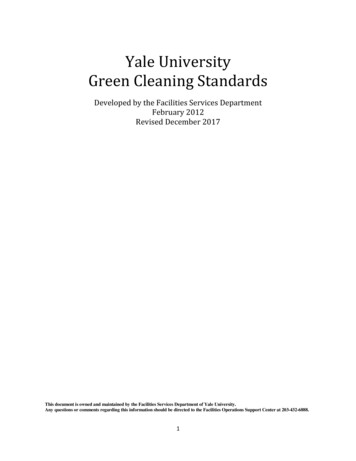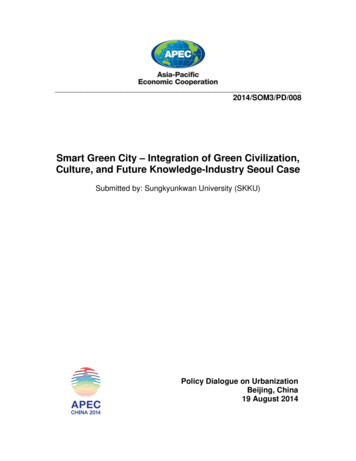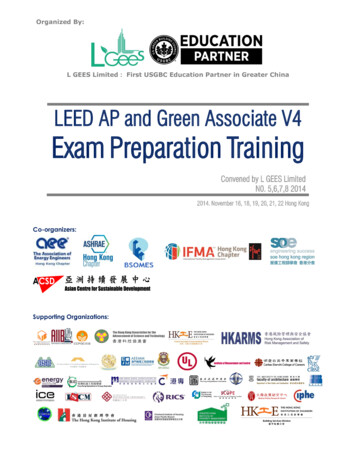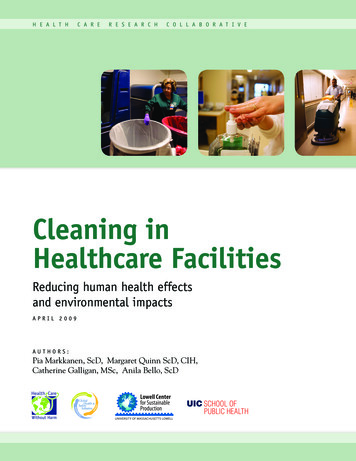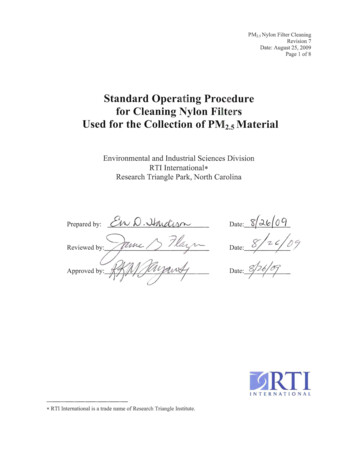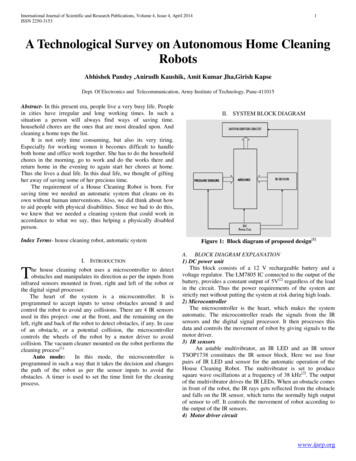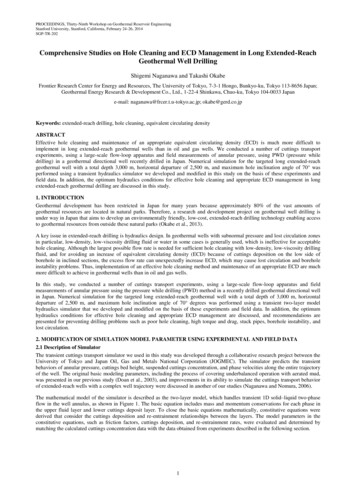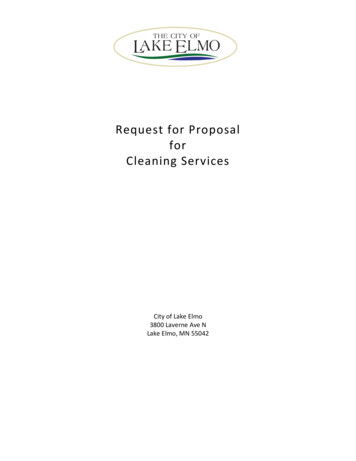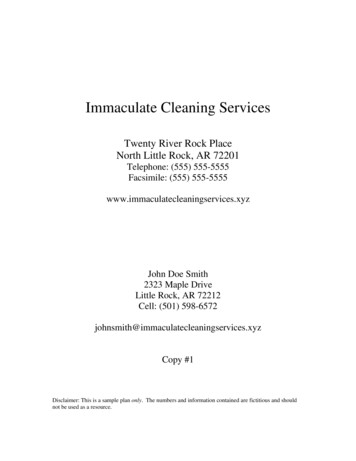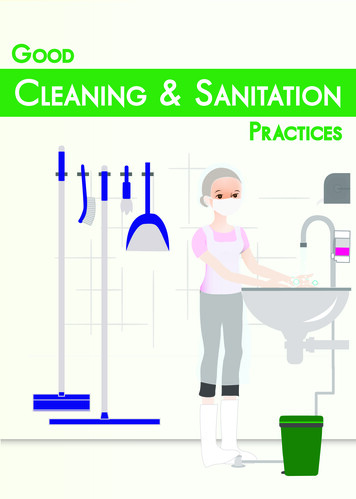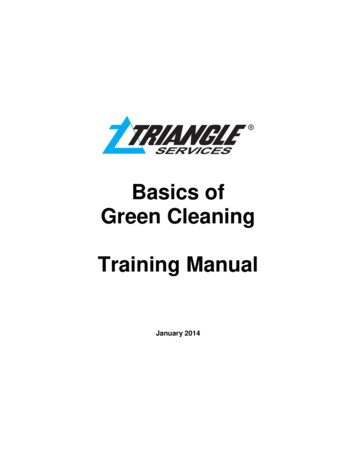
Transcription
Basics ofGreen CleaningTraining ManualJanuary 2014
B a s i c so fG r e e nC l e a n i n gTable of ContentsSection 1Introduction/Pre-Test . 4Introduction . 4Training Objectives . Error! Bookmark not defined.Terminal Objective . 5Enabling Objectives . 5Pre- and Post-Test . 5Training Course Reference Card . 6Review of Section 1 . 6Section 2Basic Green Cleaning . 7Products and Equipment Used in Green Cleaning . 7High Performance Green Cleaning Equipment . 8Sources of Soil . 9Chemical Properties of Soil . 9Microorganisms . 10Microorganisms . 10Reducing Bacterial and Viral Infections . 11Disinfectants/Sanitizers . 12Levels of Clean . 14Level 1 – Orderly Spotlessness . 15Level 2 – Ordinary Tidiness . 16Level 3 – Casual Inattention . 16Level 4 – Moderate Dinginess . 16Level 5 – Unkempt Neglect . 17Entryways . 17Basic Worker Safety. 19Cold or Hot Water for Cleaning . 20General Cleaning Rules to Follow . 20Basic Cleaning Methods/Practices . 20Dusting. 20Wiping . 21Dust-Mopping . 21Wet/Damp-Mopping . 22Auto-Scrubbing . 22Vacuuming . 222Basics of Green Cleaning Training Manual
Frequency of Cleaning and Maintenance . 23Routine Maintenance . 23Interim Maintenance . 24Restorative . 24Review of Section 2 . 243Basics of Green Cleaning Training Manual
S e c t i o n1Introduction/Pre-TestThis section will address:IntroductionTraining objectivesPre-testQuick reference cardIntroductionThe Basics of Green Cleaning course is one of several green cleaning training coursesdeveloped primarily for operations and maintenance staff at the supervisory andcustodian level. The course presents material on the following: Sources of soil in a facility; Physical/chemical characteristics of soil; Microorganisms; Reducing bacterial and viral (microorganism) infections; Disinfectants/sanitizers; Green cleaning products and equipment; “Levels of Clean” or “Service Levels”; Basic cleaning methods ; General frequency of cleaning tasks.4Basics of Green Cleaning Training Manual
Training ObjectivesTerminal ObjectiveThe terminal objective of this training course is to establish a working knowledge ofthe basic principles of green cleaning, including an introduction to green cleaningproducts and practices.Enabling ObjectivesUpon training completion, participants will be able to describe or list: Three sources of soil in a facility;The main chemical property of soil for knowledge in selecting the right cleaner;Three soils that are most effectively cleaned with an acid cleanser/detergent andthree soils that are most effectively cleaned with a alkaline cleanser/detergent;Three of the most familiar microorganisms and ways to reduce the number ofmicroorganism infections;Three issues regarding the use of disinfectants;Three benefits of green cleaning products;The four categories of green cleaning products on the Triangle Services ApprovedGreen Cleaning Products List;Two types of high-performance equipment used in green cleaning;One way to prevent soil from entering a facility and suggested requirements;The concept of “Levels of Clean”;Three benefits of defining “Levels of Clean”;Two wiping methods used in cleaning;The difference between dry-mopping and wet/damp-mopping;Routine cleaning/maintenance tasks required for a good cleaning program; andTasks that can be delayed by using good daily routine cleaning.Pre- and Post-Test Before the start of the course, a multiple-choice test (pre-test) will be given todetermine each participant’s current level of knowledge of the course content. At the end of the training course, participants will take another multiple-choice test(post-test).5Basics of Green Cleaning Training Manual
The scores of these two tests will be compared to determine the effectiveness ofthe training material and identify improvements and changes to better instructusers.Training Course Reference CardA quick reference card for this training module has been. The reference card will be ahelpful resource to use as you progress through the course, and will reinforce keypoints of the training.Review of Section 1 This section presented an introduction of what the course will cover. Course objectives were stated. Pre- and post-tests were explained.6Basics of Green Cleaning Training Manual
S e c t i o n2Basic Green CleaningThis section will address:Products and equipment used in green cleaningSources of soilChemical property of soilMicroorganismsDisinfectants/sanitizersProducts and equipment used in green cleaningLevels of cleanEntrywaysBasic cleaning methods/practicesBasic worker safetyCold or hot water for cleaningTypical facility cleaning frequenciesProducts and Equipment Used in Green CleaningGreen cleaning programs rely on the use of environmentally-sensitive chemicalproducts and high performance cleaning equipment. Green cleaning products andequipment clean as effectively as traditional products while minimizing adverse impactson people’s health and the environment. A number of years ago, many green cleaningproducts were not as effective and cost more than traditional products. However, overtime green cleaning products have become as effective as traditional products and nowcost about the same. Today, most green products undergo rigorous certification testsby organizations like Green Seal, Inc. and Ecologo to assure they are effective and safefor the consumer and environment. In addition, cleaning equipment manufacturershave also made advancements in producing products that better capture and removesoil than equipment made several years ago. Advancements include the developmentof microfiber cloths and mop heads, and special filters on vacuum cleaners called highefficiency particulate air (HEPA) filters.7Basics of Green Cleaning Training Manual
High Performance Green Cleaning EquipmentGreen cleaning requires the use of high performance cleaning equipment. Thefollowing are examples of high performance equipment and their importance,compared to traditional products, in green cleaning: Microfiber cloths, mop heads and dusters: Absorb and pick up more soil; Trap soil within the microfibers and keeps it from re-depositing onsurfaces; Reduce the amount of chemicals needed and used; and Can be laundered and reused repeatedly.Note: When laundering microfiber clothes, mop heads and dusters, donot bleach or place in a dryer, both of which can damage microfibermaterial. Green Label-certified vacuums with HEPA filters: HEPA filters improve indoor air quality by removing 99.9% of small airparticles down to 0.3 microns in size (25,400 microns are in one inch);and Meet the performance standards of the Carpet and Rug Institute. Floor burnishing machines equipped with dust collection systems to keepdust from becoming airborne; and All other items from the Triangle Services Green Cleaning Best PracticesPolicy.8Basics of Green Cleaning Training Manual
Sources of SoilSoil is defined as any substance, solid or liquid, that is present in a place where it is notwanted. For example, bottled cooking oil is not a soil, but cooking oil residue on wallsand floors caused by cooking is considered soil. Using this definition, a facility’s mainsources of soil are: Tracked-in Soil—Usually small and oily particles of silica (sand). The mostimportant part of any green cleaning program starts with the purchase, use andproper maintenance of walk-off mats for all building entrances. Placing 12 to 15feet of walk-off mats at all entryways and following an entryway maintenanceprogram will greatly reduce the amount of tracked-in soil entering the building. Airborne Soil—These are small particles of dust, droplets of oils, auto exhaust,pollen, and human dander. Air conditioning and heating systems carry airborne soilthroughout a facility. Some airborne soils are so small that they can pass throughvacuum cleaners and back into the air. Switching to an approved vacuum cleanerwith a HEPA filter is one way to reduce the amount of airborne soil in a building. Alist of Triangle Services-approved vacuum cleaners can be found on the TriangleServices Approved Green Cleaning Products List. Spills—Spills on carpeting and hard surfaces are usually noticeable and are eithera dry powder (photocopier toner, powdered cleaner, sugar, and non-dairy creamer)or liquid (ink, paint, coffee, and moist food). In most cases, custodians can cleanthese spills easily if they are reported in a timely matter. However, unreported spillsare harder or impossible to clean. In addition, soils like urine and feces foundaround restroom urinals and toilets fall under this category.Chemical Properties of SoilBy knowing the specific pH of a soil, custodians are better able to match the rightcleaning product for the soil. The symbol pH represents the amount of hydrogen ions(H ) in a solution and is measured on a scale of 0 to 14, with a pH of 7 defined asneutral. Pure water has a pH of 7. A pH less than 7 is called acidic, and a pH greaterthan 7 is called alkaline. The pH of most soils range between 3 and 9 so they areconsidered weak acids through weak alkalines. Examples of acidic soils are mixtures oforganic matter, oils, and dust. Examples of alkaline soils are mixtures of organic matterwith mineral deposits (scale), rustApplying a detergent/cleaner having the opposite pH of the soil (acid cleaner with alkalinesoils, and alkaline cleaner with acidic soils) will create a chemical reaction that helpsloosen and remove soils from a surface. You can determine the pH of the cleaner bylooking at its Material Safety Data Sheet (MSDS).9Basics of Green Cleaning Training Manual
Considering there are only two types of soil, you may only need two types of cleaners—an acidic cleaner and an alkaline cleaner. This helps reduce the number of differentproducts in your cleaning chemical inventory. However, always check the manufacturer’srecommendations for cleaners before applying cleaning solutions. For example, somemanufacturers of terrazzo flooring require a detergent that falls within a specific pH level.Failure to follow instructions may void the manufacturer’s warranty.For soils mixed with oils and grease, make sure the cleaning product containsemulsifiers to help release them from the surfac
Basics of Green Cleaning Training Manual The scores of these two tests will be compared to determine the effectiveness of the training material and identify improvements and changes to better instruct users. Training Course Reference Card A quick reference card for this training module has been. The reference card will be a
